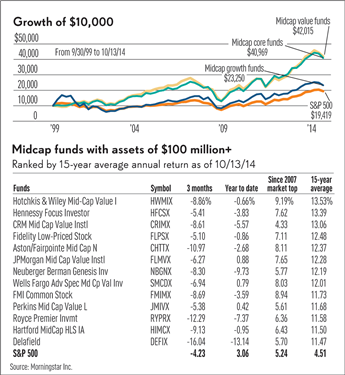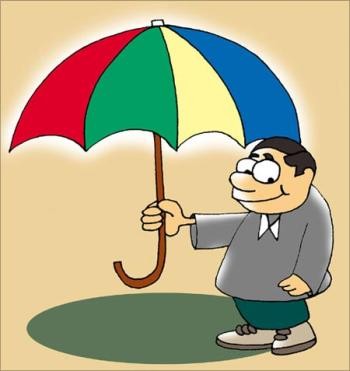Check Its LongTerm Record Before Buying a Mutual Fund
Post on: 17 Июнь, 2015 No Comment

Error.
August 6, 2011
Here’s a sure way to make a bundle: Buy funds that will do well in the future and avoid those that won’t. That’s a tough task, of course. But what’s remarkable is that most of us don’t even make decent guesses. We focus on figures that have little or no predictive power–most notably, a fund’s recent performance. The boiler-plate caution that past returns are no guarantee of future results is 100% correct. Yet performance data remain front-and-center on financial Websites; and lists of this year’s top-performing funds or fund managers grace scores of magazine covers every year.
Standard & Poor’s regular surveys document that most actively managed mutual funds trail their benchmarks virtually every year (www.standardandpoors.com ), nullifying the statistical value of short-term outperformance. Ditto for passive exchange-traded funds that are tied to indexes wagged by one set of macro factors this year and a different set next year.
Precious few mutual-fund winners repeat in subsequent years–only 1% to 2.5% of them, depending on market capitalization, manage five winning years. But–and this is a big BUT–S&P finds that those few that do manage a five-year win streak tend to keep on winning. So how do you identify them early on?
THERE ARE ELECTRONIC sources that can help you narrow the field.
finance.yahoo.com ) and, our affiliate, MarketWatch (www.marketwatch.com/investing ) are good sources of constantly updated expense and turnover data as well as multiple measures of volatility like beta and standard deviation.
The most telling positive characteristic of actively managed funds, says the Fool, is a long-tenured manager who has outperformed by sticking to his knitting–that is, executing the fund’s strategy across market cycles, rather than resorting to short-term tactics. The Fool doesn’t provide specific manager information. But Morningstar also considers leadership important and has rolled up various measures of manager quality for 1,000 large mutual funds into stewardship grades A through F. A table makes it easy to find funds whose grades match your investing strategy backed up by extensive governance profiles (www.morningstar.com/stewardship-grades ). Access to this and other premium Morningstar features costs $185 annually.
Empirical studies have uncovered several other characteristics that also augur well for fund performance. Russel Kinnel, Morningstar’s director of mutual-fund research, identifies three important ones: The star rating, expense ratios and manager records all help investors do much better than the average fund.
Manager records relate to Morningstar stewardship grades, while its 1-to-5 star ratings sum up various measures of fund quality, including long-term–not short-term–risk-adjusted returns. But the most widely published and, perhaps, most telling metric is fund cost. One way to boost returns is to build them in at the front end by choosing lower-cost funds. The less you pay upfront, the more dollars are put to work from day one.
The average management fee across all ETFs is about 0.5% with only a handful of specialty ETFs charging more than 1%. Mutual-fund management fees generally start there. Then, they also frequently carry front- or back-end loads, sales charges and higher brokerage costs and taxes due to higher turnover. But don’t rule out the mutuals, cautions Kinnel. A significant number overcome these costs to outperform their ETF counterparts by wide margins.

It turns out that neither cost nor any other single metric is equally helpful across all asset classes and strategies. Forward-looking indicators work best when considered in combination, says Kinnel. The strongest pairing, he says, is his firm’s five-star rating for a fund and those priced in the lowest fifth of fund costs. Morningstar found that cheap five-star funds are 2½ times more likely to succeed than either a one-star or a high-cost fund.
funds.us.reuters.com/US/overview.asp ) home page is dominated by recent performance information. But it also has a powerful screener to sift through 22,000 ETFs and mutual funds by predictive metrics derived from one of the Web’s best data sets. Alternatively, typing in a ticker fetches a good overview of critical information for either an ETF or a mutual fund and a handy comparison to similar funds.
ONE OF REUTERS ‘ most interesting features is a Lipper Research graphic that shows how a fund ranks against its peers across several key metrics like expenses, tax efficiency and consistency of return. A more in-depth explanation of the Lipper rationale is available on the Lipper Leaders Website (www.lipperleaders.com ) along with a screener that covers international as well as U.S. funds. Lipper is a unit of Reuters.
Reuters also provides a graph showing the tight connection between a fund’s return and its risk using measures like Sharpe Ratio and R-Squared. A Sharpe Ratio measures how well a fund achieves additional return not attributable to additional risk. The investor can use it to differentiate among similar funds.
Kind of wonky? Yes, but a fund’s alpha, or return above its benchmark, is calculated using beta. Relative performance numbers can’t be trusted if a fund’s beta is flawed–that is, not matched to the right benchmark.
Bottom line: there are better ways to pick funds than by recent returns.














